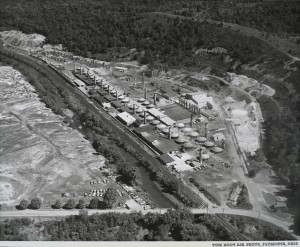John Whitacre Jr.’s story continues:
Four of the foundations for the Whitacre Fireproofing Company were in place long before the company was incorporated in 1902.  First, the origins of the coal, clay and shale formations in Stark and Carroll counties of Ohio occurred geological ages ago. These formations that featured 2 to 3 feet of coal underlain by 6 to 8 feet of fire clay and overlaid by 50 feet of shale were laminated horizontally and become known locally as the Nos. 3, 4, 5 and 6, etc., seams of coal and associated clay and shale.
First, the origins of the coal, clay and shale formations in Stark and Carroll counties of Ohio occurred geological ages ago. These formations that featured 2 to 3 feet of coal underlain by 6 to 8 feet of fire clay and overlaid by 50 feet of shale were laminated horizontally and become known locally as the Nos. 3, 4, 5 and 6, etc., seams of coal and associated clay and shale.
Second, after the ice age, the glaciers moved south, scaling the earth flat until they stopped near Canton, Ohio. The glaciers then melted, with the resulting flood waters running toward the Ohio River and cutting valleys in the earth’s surface, which exposed the coal and clay seams along the valley hillsides. Millions of years later, men had easy access to the coal and clay when these minerals were needed.
 Third, during the 1850s, railroads were build across Ohio, bringing supplies to the state and returning produce to the large cities on the East Coast and Mississippi. Crossing Ohio was a mainline railroad from Philadelphia to Chicago and another mainline from Philadelphia to St. Louis. A connecting branch between these mainlines, known as the Tuscarawas branch, was build from Alliance, Ohio, southwest to Dover, Ohio. This branch went through the villages of Waynesburg and Magnolia.
Third, during the 1850s, railroads were build across Ohio, bringing supplies to the state and returning produce to the large cities on the East Coast and Mississippi. Crossing Ohio was a mainline railroad from Philadelphia to Chicago and another mainline from Philadelphia to St. Louis. A connecting branch between these mainlines, known as the Tuscarawas branch, was build from Alliance, Ohio, southwest to Dover, Ohio. This branch went through the villages of Waynesburg and Magnolia.
The confluence of easily mined coal, clay and shale minerals and the railroad, to deliver products to the major cities, spawned the building of about 30 factories producing clay products, such as sewer pipe, paving brick, face brick, refractory brick, flue liners and tile along the Tuscarawas branch.
However, it took a fourth event, the great Chicago fire of the 1880s, to trigger the founding of the Whitacre Fireproofing Company. This fire was so devastating that in the future, walls, roofs and the steel cladding of most major buildings were built with ‘fireproofing,’ which was hollow clay tile made in dimensions such as 4 x 12 x 12. The required raw materials, coal and clay, along with the means of transportation to the cities, the railroad, were available at Waynesburg, Ohio, so the Whitacre Fireproofing Company, as the vision of J.J. Whitacre, was incorporated in 1902.


